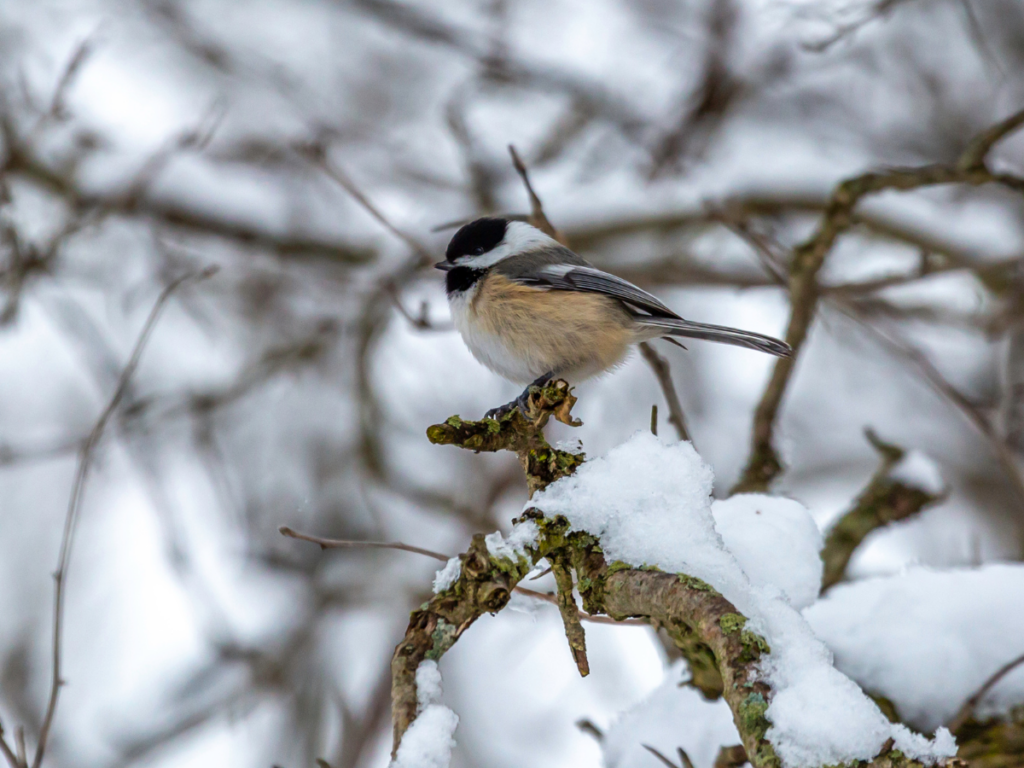Winter Warriors: How Songbirds and Raptors Survive the Colder Months
article by Ell Kinsey, Raptor Care Specialist
Nebraska is known for fluctuating temperatures. From sweaty summer days to the frosty frigid winter, all Nebraska’s inhabitants have learned to adapt—including the feathered ones!
IN THE WILD
For wild birds, there’s little time for rest in the wintertime – this is especially true of the black-capped chickadee. Weighing hardly half an ounce, these little birds are plentiful in Nebraska during the winter months. How do these birds survive a Midwest winter? Birds “floof” up to keep warm, trapping warm air between their feathers, thickening their insulation. Their bare little legs do get cold, though the Cornell Lab of Ornithology suspects birds do not feel discomfort until damage occurs from ice crystal formation. Their legs do not freeze because chickadees keep their legs and their core body temperature separate. Directing blood flow to warm their extremities costs energy these little birds must work tirelessly to replace. Their average core temperature sits around 105 degrees Fahrenheit, but their leg temperature is just above freezing. Chickadees spend their nights shivering to keep warm and their days eating to replace the fat stores they burned overnight.

A black-capped chickadee.
Other birds, like types of swallows and orioles, handle wintertime by migrating south. Migration has less to do with warmer weather and more to do with following the food. Insects do not survive in cold temperatures, so a Midwest winter makes food scarce for bug-eating songbirds.
What about wild raptors? Swainson’s Hawks are known for their extreme migratory behavior. They have been known to fly 8,000 miles from Canada to Argentina. These hawks eat small rodents like most other hawks, but grasshoppers also make up part of their diet, so it makes sense these hawks would migrate to follow their food. Osprey cannot hunt fish through a layer of ice. Even turkey vultures might struggle to seek out carrion frozen to the ground and covered by snow. These birds follow the food, just like some songbirds.
For other raptors, they’ve developed adaptations to make them more cold hardy. Great-horned owls have feathers that go all the way down their legs onto their toes, allowing them to weather the Midwest year-round. Rough-legged hawks and ferruginous hawks spend their breeding season in Canada and only descend to the Midwest for wintertime. These species also have feathers down their legs (bird pants, I like to call them). The bare-legged raptors, like red-tailed hawks, have a layer of scales on their legs which helps keep body heat in. Raptors have much sharper senses of sight and sound, which helps them locate prey that might be hiding in the snow. Barn owls have exceptional hearing and can locate a mouse beneath the snow before using their long legs to strike. The American Kestrel sees UV light, meaning it can detect traces of rodent urine, helping them to track down potential prey.
IN THE REFUGE

Rusty, a red-tailed hawk, is one of several birds who live in the Raptor Woodland Refuge year-round.
Life in the Raptor Woodland Refuge isn’t the same as life in the wild, and while this may seem unfortunate, there are benefits to birds in captivity. Because all our raptors have been deemed non-releasable, there is no safe life in the wild for them. Their disabilities put them at a disadvantage in the competition for food and nesting sites. The unforgiving Midwest winters would only make survival harder for them.
Here are just a few of the benefits our raptors enjoy:
- Heaters: Migratory raptors, like our three Swainson’s hawks, Grasshopper, Savanna, and Dakini, aren’t designed to live in the cold. These birds enjoy heated enclosures during the winter months. To keep the heat in, you may notice some of our raptors have been closed inside.
- Clean water sources: Raptors get a majority of their moisture from their food, and only drink liquid water to supplement what their food can’t provide. The dishes also provide a place to bathe. When the temperature falls below freezing, not only is it difficult for raptors to find liquid water, it can be dangerous to bathe in unregulated temperatures.
- Consistent meals: Wild raptors don’t catch every rodent they attempt to snatch. There are days wild birds go without food, and because birds expend energy to stay warm, that can be detrimental to survival. Our raptors here in the Refuge get a consistent meal every day.
When visiting the Refuge, you may notice not all the birds have heaters. You may notice not all the birds have been closed inside. Recognize that these birds are more cold-hardy than the ones inside. Cinnamon and Minerva the great-horned owls, Mesa the ferruginous hawk, Smokey the rough-legged hawk, and Fisher and Freedom the eagles have feathered legs. These birds are more resilient than we give them credit for. We still monitor the weather and would of course close the birds in should there be inclement weather. As for Freyja the gyrfalcon, well, let’s say our coldest winter day is still summertime for her!
For more information on raptors and cold temperatures, check out these articles from the Cornell Lab of Ornithology:


